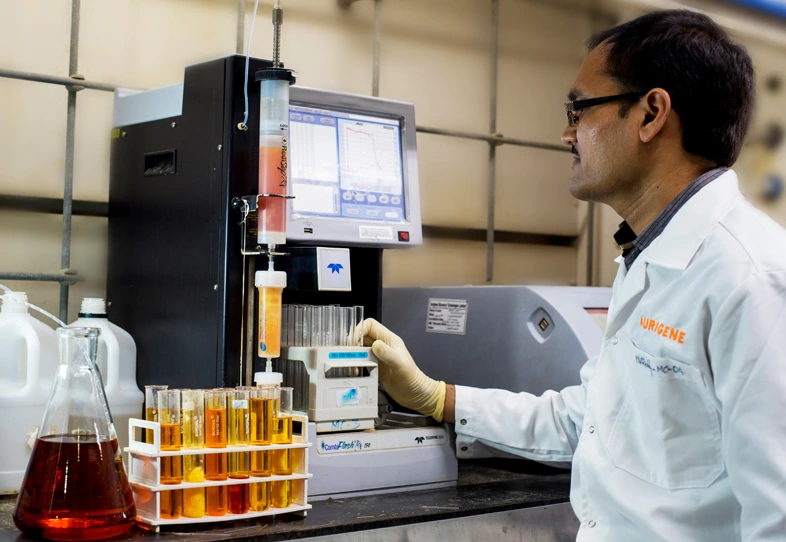

CADD Services
We follow a holistic approach to discovery projects by investigating the target of interest and understanding the biomolecular mechanism. We have standardized methodology and developed innovative approaches through highly skilled scientists for solving complex problems related to discovery. The CADD facility routinely supports discovery projects starting from target identification to positioning of the candidate compound. We have a wide range of tools available for compound optimization. We have proven expertise in collaborative small molecule and niche therapeutics modalities, namely Peptides, Target protein degradation (PROTAC & Molecular glues), Antibody and ADC design, and Oligonucleotides (includes aptamer and siRNA) related drug discovery projects.
Bioinformatics services
Aurigene has established expertise, design methods to support design and optimization of efficacious, safe, novel candidate development for niche therapeutics modalities namely Peptides, Target protein degradation (PROTAC & Molecular glues), Antibody and ADC design, Oligonucleotides (includes aptamer and siRNA) related drug discovery projects.
Capabilities: Ontology analysis, Pathway database, Network comparison , Data visualization, Network generation, Network analysis, Graph analysis, Online data import and analysis, Automation, Integrated analysis, Clustering, Structural bioinformatics, Systems biology, Enrichment analysis, Visualization, Data integration, Layout generation, Sequence database manipulation, Target analysis, Next Generation Sequencing analysis, Biological pathway, Structural insight/Protein structure prediction, Translational biology, Competition analysis
Peptides: Structure Prediction, Protein-Protein Interactions (PPIs), Protein Hotspot Prediction, Generative Peptide Design, Peptide Property Optimization
Biologics: De novo protein design, Protein-protein biding affinity, Protein Humanization, Protein Off-Target prediction, Therapeutic Protein Development
Oligonucleotides: siRNA design, mRNA vaccine sequence optimization, Structure and Ligand based compound design, Aptamer design






Why Aurigene CADD (computer-aided drug design) and Informatics Services?
3-D virtual reality facility
High-end software for simulation & modeling (Schrodinger, MolSoft)
NVIDIA GPU cluster to support high end simulation and modeling
Team led by domain expert in CADD and Informatics
Connect with our scientific experts for your drug discovery, development, and manufacturing needs
We understand that clear communication is essential to successful collaborations, and that's why we have a dedicated team that is always ready to help you. Whether you have questions about our services, want to discuss a potential partnership, or simply want to learn more about our company, we're here to help.
Our team of experts is dedicated to providing personalised solutions tailored to your unique needs. So, please don't hesitate to reach out to us. We look forward to hearing from you and helping you achieve your business goals.
Learning Resources

JUNE 28, 2022
Neoantigen Specific T cells For Cancer Immunotherapy
An effective anti-tumor immune response in human is marked by presence of T cells reactive against neoantigens. Neoantigens are HLA-bound unique peptides arise from tumor-specific somatic mutations. Neoantigens are highly immunogenic because they are not present in normal tissues and hence bypass central thymic tolerance. The success of immune checkpoint blockade...
Read More
Evolution in Pharma Industry and Demand for Integrated CDMO
The pharma industry is evolving and a demand for integrated CDMOs, which can help accelerating innovations, is part of the evolution....
Read More
Biologics Process Development Services
Our strength is built on a deep understanding of cell culture, protein chemistry and an integrated analytics platform enabling a robust, scalable and controlled process. ...
Read More
Systematic formulation design - shorten development cost & time
Project Challenge: Existing formulation (lower strength - 50 mg) was manufactured using direct compression process. This formulation posed poor powder flow and content uniformity issues during scale-up. Development of new strength 150 mg without any process issues was a challenge. Solution design: Preliminary pre-formulation, stress study and PSD impact assessmen...
Read MoreAugust 28, 2020
Cu-catalyzed coupling-cyclization in PEG 400 under ultrasound: a highly selective and greener approach towards isocoumarins
The combination of CuI–K2CO3-PEG 400 facilitated the couplingcyclization of o-iodobenzoic acid with terminal alkynes under ultrasound, affording a greener and practical approach towards 3-substituted isocoumarins with remarkable regioselectivity. This inexpensive and Pd and ligand free methodology gave rise to various isocoumarins of potential pharmacological i...
Read More-
January 31, 2025
Development and assessment of a Bcs class II - SGLT2 (Sodium Glucose Cotransporter 2) inhibitor drug in the form of solid lipid Nanoparticles by selecting different lipids, co-surfactants, and manufacturing techniques
Drug Delivery System (DDS) has been used successfully in the past few decades to cure illnesses and enhance health because of its improved systemic circulation and ability to regulate the drug's pharmacological action. As pharmacology and pharmacokinetics advanced, the idea of controlled release emerged, demonstrating the significance of drug release in assessing...
Read More -
January 31, 2025
Development of novel paullone-based PROTACs as anticancer agents
Proteolysis-targeting chimera (PROTACs) represents a promising modality that has gained significant attention for cancer treatment. Using PROTAC technology, we synthesized novel structurally modified paullone-based PROTACs using Cereblon (CRBN) and Von Hippel–Lindau (VHL) E3 ligands....
Read More -
March 13, 2025
Development and verification of RP-HPLC method for the quantitative determination of Decitabine in tablet dosage formulation
Decitabine is an anti-cancer chemotherapy drug. This article describes method development and method verification of Assay of Decitabine in tablet formulation. A new, precise, rapid, accurate RP-HPLC method has been developed for the estimation of Decitabine in pharmaceutical tablets dosage form. After optimization the good chromatographic separation was achieved...
Read More
You are about to leave Aurigene Pharmaceutical Services and affiliates website. Aurigene Pharmaceutical Services assumes no responsibility for the information presented on the external website or any further links from such sites. These links are presented to you only as a convenience, and the inclusion of any link does not imply endorsement by Aurigene Pharmaceutical Services.
If you wish to continue to this external website, click Proceed.


Leaving already?
Don't forget to join us at
CPHI Worldwide 2023.
October 24th-26th, 2023 | Barcelona, Spain
Get ready to accelerate your drug’s journey to the market




















